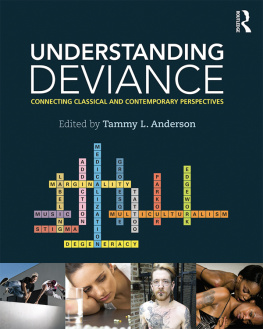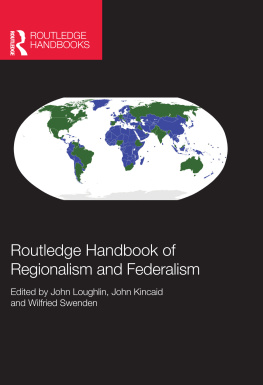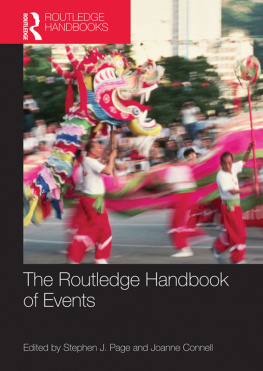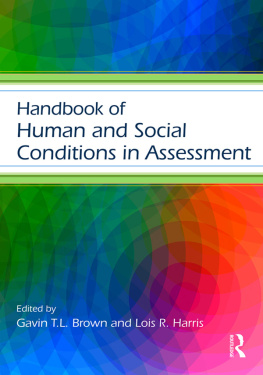Brown Stephen E. - Routledge Handbook on Deviance
Here you can read online Brown Stephen E. - Routledge Handbook on Deviance full text of the book (entire story) in english for free. Download pdf and epub, get meaning, cover and reviews about this ebook. City: London;New York, year: 2019, publisher: Taylor & Francis (CAM);Routledge, genre: Art. Description of the work, (preface) as well as reviews are available. Best literature library LitArk.com created for fans of good reading and offers a wide selection of genres:
Romance novel
Science fiction
Adventure
Detective
Science
History
Home and family
Prose
Art
Politics
Computer
Non-fiction
Religion
Business
Children
Humor
Choose a favorite category and find really read worthwhile books. Enjoy immersion in the world of imagination, feel the emotions of the characters or learn something new for yourself, make an fascinating discovery.
- Book:Routledge Handbook on Deviance
- Author:
- Publisher:Taylor & Francis (CAM);Routledge
- Genre:
- Year:2019
- City:London;New York
- Rating:3 / 5
- Favourites:Add to favourites
- Your mark:
- 60
- 1
- 2
- 3
- 4
- 5
Routledge Handbook on Deviance: summary, description and annotation
We offer to read an annotation, description, summary or preface (depends on what the author of the book "Routledge Handbook on Deviance" wrote himself). If you haven't found the necessary information about the book — write in the comments, we will try to find it.
Routledge Handbook on Deviance — read online for free the complete book (whole text) full work
Below is the text of the book, divided by pages. System saving the place of the last page read, allows you to conveniently read the book "Routledge Handbook on Deviance" online for free, without having to search again every time where you left off. Put a bookmark, and you can go to the page where you finished reading at any time.
Font size:
Interval:
Bookmark:
Deviance, one of the most interesting and vibrant areas of research, is presented richly and persuasively alive in this up-to-date, captivating book. In it, an esteemed group of first-rate scholars produce a remarkably broad contemporary and brilliant perspective on the various and intriguing manifestations of deviant behaviors. This is certainly a must-read for anyone interested not only in the study of deviance, but on how deviance affects culture and society.
Nachman Ben-Yehuda , Department of Sociology and Anthropology, Hebrew University
First published 2018
by Routledge
711 Third Avenue, New York, NY 10017
and by Routledge
2 Park Square, Milton Park, Abingdon, Oxon, OX14 4RN
Routledge is an imprint of the Taylor & Francis Group, an informa business
2018 Taylor & Francis
The right of Stephen E. Brown and Ophir Sefiha to be identified as the authors of the editorial material, and of the authors for their individual chapters, has been asserted in accordance with sections 77 and 78 of the Copyright, Designs and Patents Act 1988.
All rights reserved. No part of this book may be reprinted or reproduced or utilised in any form or by any electronic, mechanical, or other means, now known or hereafter invented, including photocopying and recording, or in any information storage or retrieval system, without permission in writing from the publishers.
Trademark notice : Product or corporate names may be trademarks or registered trademarks, and are used only for identification and explanation without intent to infringe.
Library of Congress Cataloging-in-Publication Data
Names: Brown, Stephen Eugene, 1951 editor. | Sefiha, Ophir, editor.
Title: Routledge handbook on deviance / edited by Stephen E. Brown and Ophir Sefiha.
Other titles: Handbook of deviant behaviour
Description: 1 Edition. | New York : Routledge, 2018.
Identifiers: LCCN 2017020827 | ISBN 9781138124578 (hardback) | ISBN 9781315648057 (ebk)
Subjects: LCSH: Deviant behavior.
Classification: LCC HM811 .R684 2018 | DDC 302.5/42dc23
LC record available at https://lccn.loc.gov/2017020827
ISBN: 978-1-138-12457-8 (hbk)
ISBN: 978-1-315-64805-7 (ebk)
Typeset in Bembo
by Apex CoVantage, LLC

Defining and Studying Deviance
Outside of scholars of deviance, most construe the phenomenon as comprised of bad characteristics or behavior. Indeed, even among accomplished social science scholars, deviance is often envisioned within a narrow framework of purportedly harmful or undesirable characteristics that ascribe ill will to the deviant. Even informed reviewers of the original proposal for this Handbook on Deviance took umbrage at our inclusion of several illnesses and religious orientations. Yet as Pat Lauderdale outlines in the opening chapter, the concept of deviance may be extended well beyond negative behaviors and conditions alone.
Central to understanding deviance is its relativity (Curra, 2017). That is, what is successfully defined as deviant will vary across time and space. Using the deviant label of terrorist as an example, Lauderdale poses the question of who is successfully so labeled. The answer to such questions, it is asserted, goes beyond time and place. Citing Oliverio (1998: 5), it is offered that it is revealing to examine the political processes and practices that maintain, create, and change the definitions of certain acts as terrorist. Deviance, Lauderdale contends, can be viewed as reactions to diversity: how and why some behaviors and conditions across a continuum are successfully labeled deviant while others are not. In fact, there exists a plethora of examples of behaviors that threaten human life yet avoid state definition as deviant (criminalization), while other behaviors lacking evidence of harm to others are so criminalized (Brown et al., 2015). Central to accepting a diverse range of human behaviors and conditions versus their designation as deviant is a function of the distribution and role of power. Lauderdale cites Kai Eriksons (1966/2004) classic analysis of New England Puritans creation of deviance and Thomas Horejess (2013) examination of the political defining of disabilism in making the case that hegemony, domination through cultural control, creates deviance from diversity.
Undoubtedly, societal reactions and the power marshaled behind them shape the deviance chronicle. Yet many theoretical frameworks seek to explain the origin and continuity of behaviors that ostensibly violate norms, perhaps bringing social harm. Defining deviance as norm violation, Sren Kristiansen reviews the historically preeminent efforts to explain deviance.
First reviewed is Edwin Sutherlands differential association portraying deviance as entirely a function of the social process of learning, successfully casting criminology within the sociological domain in the mid-twentieth century. In quite a different vein, and echoing many of Lauderdales views of deviance, Kristiansen outlines the conflict perspective. In particular, summarized is the Marxian economic view that a ruling class creates a surplus population of deviants. Returning to a dominant mainstream theory, Robert Mertons (1938) landmark casting of anomie as a product of social structure is summarized. Finally, accentuating the diversity of explanations of deviance that have been proffered, Kristiansens theoretical discussion is closed with the labeling perspective that deviance is created by the response of others rather than the behavior of the actor who is dubbed deviant. This creation of deviance through social reaction echoes the relativity of deviance and is reflected in many of the chapters of this handbook.
Equally crucial to the study of deviance, along with a theoretical framework, are the methods of study. Kristiansens chapter summarizes and contrasts qualitative and quantitative approaches to the study of deviance. The chapter closes with an examination of longitudinal designs as a technique for attempting to sort out causal order in understanding deviance.
One of the goals of this volume was to construe deviance in the broadest sense. Nicole A. Shoenbergers review of the concept of positive deviance provides a framework for analyzing the full range of human behavior and reactions to it. Normative behavior is distributed across a bell-shaped curve, with positive deviance representing the counterpart to the much more frequently examined negative deviance. Shoenberger makes the case that the extension to include positive deviance yields a more vibrant and complete deviance field.
The Shoenberger chapter reveals the lack of accord in defining and conceptualizing this emerging theoretical extension of deviance. Of particular interest are those who exceed normative expectations only to face negative sanctions. Examples include the A student being viewed as a rate-buster, the aging athlete who refuses to age gracefully, or the highly devout religious individual being labeled an extremist. This has important implications for understanding labeling and stigma. While some debate the value of recognizing positive deviance, it is surely of value in understanding the dynamics of stigmatization.
This opening collection of essays, setting the stage for the nine groupings to follow, concludes with a chapter examining the role of the media in defining deviance. Gray Cavender discusses media power in the context of sport frames, thus also providing a transition into the next set of chapters addressing sport and deviance.
If deviance is to be understood as norm violations, negative reactions to behavior, and/or stigma-tizing selective behaviors or qualities, the shaping of both norms and reactions to behaviors/qualities is critical. Cavenders widely shared contention is that the media play a major role in deviance construction. Investigating sports as an example, ample evidence of media glorification of athletes and athletics is unveiled, even while some coverage is allotted to both deviant behavior of athletes and institutional sports deviance.
Font size:
Interval:
Bookmark:
Similar books «Routledge Handbook on Deviance»
Look at similar books to Routledge Handbook on Deviance. We have selected literature similar in name and meaning in the hope of providing readers with more options to find new, interesting, not yet read works.
Discussion, reviews of the book Routledge Handbook on Deviance and just readers' own opinions. Leave your comments, write what you think about the work, its meaning or the main characters. Specify what exactly you liked and what you didn't like, and why you think so.










